Configuración de Multicast sobre LISP Fase 1
Opciones de descarga
-
ePub (2.6 MB)
Visualice en diferentes aplicaciones en iPhone, iPad, Android, Sony Reader o Windows Phone -
Mobi (Kindle) (1.7 MB)
Visualice en dispositivo Kindle o aplicación Kindle en múltiples dispositivos
Lenguaje no discriminatorio
El conjunto de documentos para este producto aspira al uso de un lenguaje no discriminatorio. A los fines de esta documentación, "no discriminatorio" se refiere al lenguaje que no implica discriminación por motivos de edad, discapacidad, género, identidad de raza, identidad étnica, orientación sexual, nivel socioeconómico e interseccionalidad. Puede haber excepciones en la documentación debido al lenguaje que se encuentra ya en las interfaces de usuario del software del producto, el lenguaje utilizado en función de la documentación de la RFP o el lenguaje utilizado por un producto de terceros al que se hace referencia. Obtenga más información sobre cómo Cisco utiliza el lenguaje inclusivo.
Acerca de esta traducción
Cisco ha traducido este documento combinando la traducción automática y los recursos humanos a fin de ofrecer a nuestros usuarios en todo el mundo contenido en su propio idioma. Tenga en cuenta que incluso la mejor traducción automática podría no ser tan precisa como la proporcionada por un traductor profesional. Cisco Systems, Inc. no asume ninguna responsabilidad por la precisión de estas traducciones y recomienda remitirse siempre al documento original escrito en inglés (insertar vínculo URL).
Contenido
Introducción
Este documento describe que en la fase 1 de la implementación de multidifusión sobre el protocolo de separación Localizador/ID (LISP), se utiliza la replicación de ingreso. Esto significa que el núcleo del localizador de routing de unidifusión (RLOC) se utiliza para transportar multidifusión de información de identidad (EID).
Prerequisites
Requirements
Cisco recomienda que tenga conocimiento de LISP y multidifusión.
Componentes Utilizados
Este documento no tiene restricciones específicas en cuanto a versiones de software y de hardware.
The information in this document was created from the devices in a specific lab environment. All of the devices used in this document started with a cleared (default) configuration. If your network is live, make sure that you understand the potential impact of any command.
Configurar
Diagrama de la red
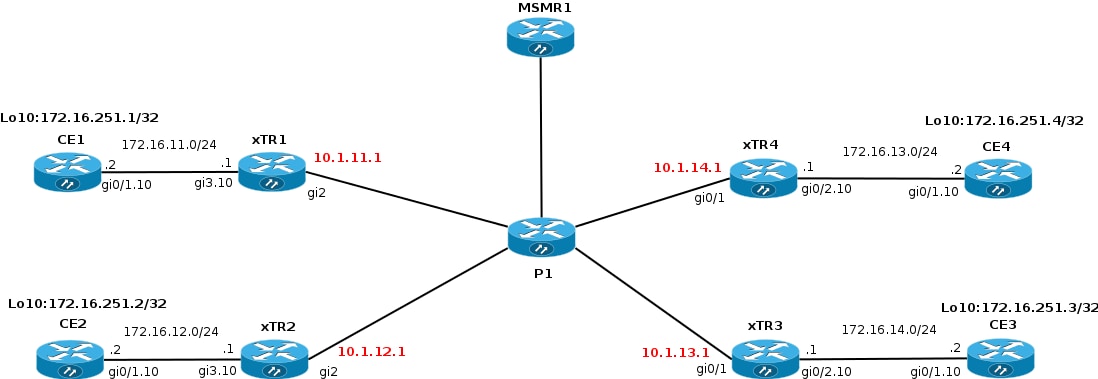
Configuraciones
La Fase 1 soporta la replicación de cabecera de unidifusión de los paquetes multicast.
- El soporte de la Fase 1 comienza en XE 3.13 y Cisco IOS® 15.4(2)T.
- La Fase 1 admite EID de IPv4 sobre RLOCs de IPv4 (el transporte) comienza en XE 3.13 y Cisco IOS® 15.4(2)T.
- La fase 1 admite EID de IPv6 sobre RLOCs IPv4 (transporte) comienza en Polaris 16.6.1 en vrf predeterminado sólo para LISP con encapsulación VXLAN para acceso definido por software (SDA).
- La Fase 1 admite routing y reenvío virtual (VRF) EID (segmentación) con IID (a través de la compatibilidad con VRF PIM).
- La fase 1 admite los modelos Any Source Multicast (ASM) y Source Specific Multicast (SSM).
- La Fase 1 admite solamente la configuración estática del procesador de ruta (RP).
- La Fase 1 no soporta la redundancia RP.
- La Fase 1 admite varias combinaciones de sitios receptores y de origen no compatibles con LISP.
- LISP Multicast NO se admite como solución LISP Mobility Data Center Interconnect (DCI).
Se supone que la multidifusión ya está configurada en la red (pim sparse-mode/rp).
Para habilitar multicast sobre LISP, debe agregar "ip pim sparse-mode" bajo una interfaz LISP0 o LISP0.xx. Al habilitar PIM en una interfaz LISP, se incluye en RPF. La información de RPF para los prefijos a los que se puede acceder a través de sitios LISP consiste en un túnel LISP y un vecino representado por una dirección RLOC de un sitio ascendente.
Sólo se permite enviar mensajes de unión/separación a través de túneles LISP. Los mensajes de saludo PIM no se intercambian entre sitios. Los mensajes de unión/separación PIM se encapsulan en unidifusión en un xTR ascendente (RP o fuente). Otros xTRs/PxTRs no ven los mensajes de unión/separación. No hay analógico de MDT predeterminado en MVPN.
El PIM se debe habilitar en interfaces de túnel LISP para el procesamiento multidifusión.
La virtualización EID utiliza ID de instancia LISP junto con VRF EID. Una interfaz LISP0.x donde x=IID se crea para cada ID de instancia EID VRF/LISP.
xTR1#sh run
!
interface LISP0
ip pim sparse-mode <<<< PIM under the LISP interface
!
interface LISP0.20
ip pim sparse-mode <<<< PIM under the LISP interface
end
xTR1#sh ip pim int
Address Interface Ver/ Nbr Query DR DR
Mode Count Intvl Prior
172.16.11.1 GigabitEthernet3.10 v2/S 1 30 1 172.16.11.2
10.1.255.1 LISP0 v2/S 0 30 1 10.1.255.1
No se ven vecinos a través de una interfaz LISP porque no hay fuentes/receptores activos y los saludo PIM no se intercambian entre peers.
xTR1#sh ip pim nei
PIM Neighbor Table
Mode: B - Bidir Capable, DR - Designated Router, N - Default DR Priority,
P - Proxy Capable, S - State Refresh Capable, G - GenID Capable,
L - DR Load-balancing Capable
Neighbor Interface Uptime/Expires Ver DR
Address Prio/Mode
172.16.11.2 GigabitEthernet3.10 01:43:52/00:01:34 v2 1 / DR S P G
SSM
Configuremos la interfaz lo10 en el CE2 para unirse a un grupo. Activa una Unión (S,G) porque se especifica un grupo y un origen.
CE2#conf t Enter configuration commands, one per line. End with CNTL/Z. CE2(config)#int lo10 CE2(config-if)#ip igmp join-group 232.1.1.10 source 172.16.251.1 *Nov 26 18:28:55.471: PIM(0): Insert (172.16.251.1,232.1.1.10) join in nbr 172.16.12.1's queue *Nov 26 18:28:55.491: PIM(0): Building Join/Prune packet for nbr 172.16.12.1 *Nov 26 18:28:55.491: PIM(0): Adding v2 (172.16.251.1/32, 232.1.1.10), S-bit Join *Nov 26 18:28:55.492: PIM(0): Send v2 join/prune to 172.16.12.1 (GigabitEthernet0/1.10) *Nov 26 18:28:56.856: PIM(0): Send v2 join/prune to 172.16.12.1 (GigabitEthernet0/1.1
La ruta multicast (S,G) se crea en CE2.
CE2#sh ip mro 232.1.1.10
<…skip…>
(172.16.251.1, 232.1.1.10), 00:00:16/00:02:45, flags: sLTI
Incoming interface: GigabitEthernet0/1.10, RPF nbr 172.16.12.1
Outgoing interface list:
Loopback10, Forward/Sparse, 00:00:14/00:02:45
Veamos qué sucede con xTR2.
Debug ip pim está habilitado en xTR2.
Se recibe la incorporación (S,G) de CE2.
*Nov 26 18:38:19.641: PIM(0): Received v2 Join/Prune on GigabitEthernet3.10 from 172.16.12.2, to us *Nov 26 18:38:19.641: PIM(0): Join-list: (172.16.251.1/32, 232.1.1.10), S-bit set
172.16.251.1 es el EID de xTR1 y todavía no está presente en el RIB. Debido a esto, la búsqueda de RPF falla para la IP de origen 172.16.251.1. Activa la búsqueda de LISP. La interfaz RPF es el túnel LISP.
*Nov 26 18:38:19.641: PIM(0): RPF Lookup failed for 172.16.251.1 *Nov 26 18:38:19.643: PIM(0): Add GigabitEthernet3.10/172.16.12.2 to (172.16.251.1, 232.1.1.10), Forward state, by PIM SG Join *Nov 26 18:38:19.650: PIM(0): Insert (172.16.251.1,232.1.1.10) join in nbr 10.1.11.1's queue xTR2#sh ip rpf 172.16.251.1 RPF information for ? (172.16.251.1) RPF interface: LISP0 RPF neighbor: ? (10.1.11.1) RPF route/mask: 172.16.251.1/32 RPF type: unicast () Doing distance-preferred lookups across tables RPF topology: ipv4 multicast base
Después de eso, se genera una Unión (S,G) y se envía a través de la interfaz LISP al origen a través de RLOC 10.1.11.1.
*Nov 26 18:38:19.650: PIM(0): Building Join/Prune packet for nbr 10.1.11.1 *Nov 26 18:38:19.650: PIM(0): Adding v2 (172.16.251.1/32, 232.1.1.10), S-bit Join *Nov 26 18:38:19.650: PIM(0): Adding LISP Unicast transport attribute in join/prune to 10.1.11.1 (LISP0) *Nov 26 18:38:19.650: PIM(0): Send v2 join/prune to 10.1.11.1 (LISP0)
Una Unión se encapsula en el encabezado de unidifusión LISP. La IP de origen del paquete encapsulado es un RLOC de la interfaz a través de la cual se envía el paquete. La IP de destino es la dirección RLOC del xTR que tiene alcance al EID del origen multicast.
xTR2#sh ip lisp map-cache 172.16.251.1
LISP IPv4 Mapping Cache for EID-table default (IID 0), 4 entries
172.16.251.1/32, uptime: 02:18:16, expires: 21:41:44, via map-reply, complete
Sources: map-reply
State: complete, last modified: 02:18:16, map-source: 10.1.11.1
Idle, Packets out: 41(4838 bytes) (~ 01:21:15 ago)
Locator Uptime State Pri/Wgt
10.1.11.1 02:18:16 up 100/100
Last up-down state change: 02:18:16, state change count: 1
Last route reachability change: 02:18:16, state change count: 1
Last priority / weight change: never/never
RLOC-probing loc-status algorithm:
Last RLOC-probe sent: never
Para poder enviar una unión, necesita tener un vecino PIM. Una vez obtenida la información de RPF, PIM crea explícitamente un vecino al RLOC correspondiente. El vecino no se crea de la forma habitual porque los saludo PIM no pasan por el túnel LISP.
xTR2#sh ip pim nei
PIM Neighbor Table
Mode: B - Bidir Capable, DR - Designated Router, N - Default DR Priority,
P - Proxy Capable, S - State Refresh Capable, G - GenID Capable,
L - DR Load-balancing Capable
Neighbor Interface Uptime/Expires Ver DR
Address Prio/Mode
172.16.12.2 GigabitEthernet3.10 01:57:04/00:01:30 v2 1 / DR S P G
10.1.11.1 LISP0 00:00:48/00:01:10 v2 0 /
Una captura de Wireshark del paquete multicast es como se muestra en la imagen.
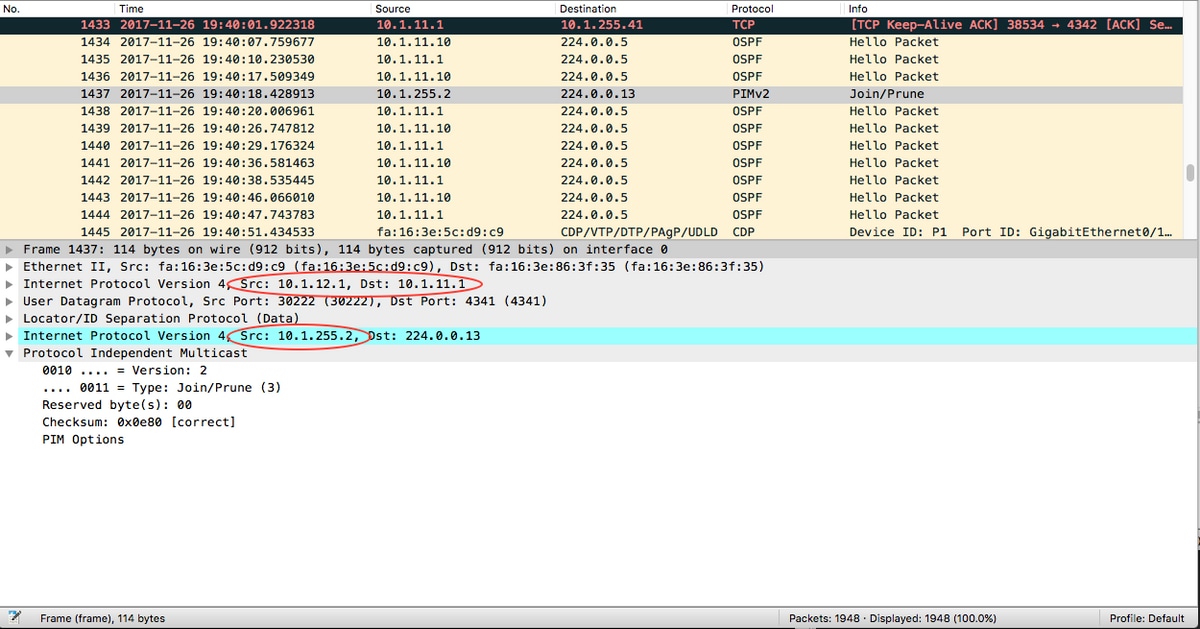
La IP de origen y destino externa son RLOC locales y remotos. Se espera a medida que se utiliza la replicación de unidifusión.
La IP de origen interna se tomó de la interfaz LISP0.
xTR2#sh int LISP0 | i unn Interface is unnumbered. Using address of Loopback0 (10.1.255.2)
La IP de destino interno es la dirección multicast 224.0.0.13 que se utiliza para los mensajes PIM.
En xTR2 para la ruta multicast (172.16.251.1, 232.1.1.10) un IIL es la interfaz LISP0 y un OIL apunta a CE2.
xTR2#show ip mroute
<…skip…>
(172.16.251.1, 232.1.1.10), 00:00:36/00:02:55, flags: sT
Incoming interface: LISP0, RPF nbr 10.1.11.1
Outgoing interface list:
GigabitEthernet3.10, Forward/Sparse, 00:00:36/00:02:55
xTR2#sh ip mfib
<…skip…>
(172.16.251.1,232.1.1.10) Flags: HW
SW Forwarding: 0/0/0/0, Other: 0/0/0
HW Forwarding: 0/0/0/0, Other: 0/0/0
LISP0 Flags: A
GigabitEthernet3.10 Flags: F NS
Pkts: 0/0
En xTR1, se recibió una Unión de xTR2 y se creó una ruta multicast (S,G).
*Nov 26 18:38:19.464: PIM(0): Received v2 Join/Prune on LISP0 from 10.1.255.2
*Nov 26 18:38:19.464: PIM(0): J/P Transport Attribute, Transport Type: Unicast, to us
*Nov 26 18:38:19.464: PIM(0): Join-list: (172.16.251.1/32, 232.1.1.10), S-bit set
*Nov 26 18:38:19.467: PIM(0): Add LISP0/10.1.12.1 to (172.16.251.1, 232.1.1.10), Forward state, by PIM SG Join
*Nov 26 18:38:19.467: PIM(0): Insert (172.16.251.1,232.1.1.10) join in nbr 172.16.11.2's queue
*Nov 26 18:38:19.467: PIM(0): Building Join/Prune packet for nbr 172.16.11.2
*Nov 26 18:38:19.467: PIM(0): Adding v2 (172.16.251.1/32, 232.1.1.10), S-bit Join
*Nov 26 18:38:19.467: PIM(0): Send v2 join/prune to 172.16.11.2 (GigabitEthernet3.10)
xTR1#sh ip mroute
<…skip…>
(172.16.251.1, 232.1.1.10), 00:01:00/00:03:28, flags: sT
Incoming interface: GigabitEthernet3.10, RPF nbr 172.16.11.2
Outgoing interface list:
LISP0, 10.1.12.1, Forward/Sparse, 00:01:00/00:03:28 <<<< LISP in OIL
Upstream xTR1 debe realizar un seguimiento de cada RLOC descendente para el que se ha recibido un mensaje Join.
El xTR debe recordar el conjunto de RLOC a los que se replican los paquetes.
Por lo tanto, una entrada (EIDs,G) en el xTR ascendente se ve de la siguiente manera para la encapsulación unicast:
(EIDs,G)
A Eth0/0
F LISP0, nexthop = RLOC1
F LISP0, nexthop = RLOC2
xTR1#sh ip mfib
<…skip…>
(172.16.251.1,232.1.1.10) Flags: HW
SW Forwarding: 0/0/0/0, Other: 0/0/0
HW Forwarding: 0/0/0/0, Other: 0/0/0
GigabitEthernet3.10 Flags: A
LISP0, 10.1.12.1 Flags: F NS <<<<
Pkts: 0/0
Nota: xTR1 no tiene un vecino PIM a través de la interfaz LISP0.
xTR1# sh ip pim nei
PIM Neighbor Table
Mode: B - Bidir Capable, DR - Designated Router, N - Default DR Priority,
P - Proxy Capable, S - State Refresh Capable, G - GenID Capable,
L - DR Load-balancing Capable
Neighbor Interface Uptime/Expires Ver DR
Address Prio/Mode
172.16.11.2 GigabitEthernet3.10 04:25:32/00:01:37 v2 1 / DR S P G
En CE1 se recibió una Unión para un (S,G) y se creó una ruta multicast.
CE1#sh ip mro
<…skip…>
(172.16.251.1, 232.1.1.10), 02:16:45/00:03:08, flags: sT
Incoming interface: Loopback10, RPF nbr 0.0.0.0
Outgoing interface list:
GigabitEthernet0/1.10, Forward/Sparse, 02:16:45/00:03:08
El tráfico de multidifusión fluye como se esperaba.
CE1#ping 232.1.1.10 so lo10 rep 5 Type escape sequence to abort. Sending 5, 100-byte ICMP Echos to 232.1.1.10, timeout is 2 seconds: Packet sent with a source address of 172.16.251.1 Reply to request 0 from 172.16.251.2, 11 ms Reply to request 0 from 172.16.251.2, 15 ms Reply to request 1 from 172.16.251.2, 14 ms Reply to request 1 from 172.16.251.2, 15 ms Reply to request 2 from 172.16.251.2, 12 ms Reply to request 2 from 172.16.251.2, 16 ms Reply to request 3 from 172.16.251.2, 9 ms Reply to request 3 from 172.16.251.2, 13 ms Reply to request 4 from 172.16.251.2, 9 ms Reply to request 4 from 172.16.251.2, 9 ms
Añadamos un receptor más en CE3.
Se agrega una entrada adicional en un PETRÓLEO para el nuevo RLOC en un MRIB y un MFIB.
xTR1#sh ip mro 232.1.1.10
<…skip…>
(172.16.251.1, 232.1.1.10), 02:28:36/00:03:25, flags: sT
Incoming interface: GigabitEthernet3.10, RPF nbr 172.16.11.2
Outgoing interface list:
LISP0, 10.1.13.1, Forward/Sparse, 00:01:34/00:02:57
LISP0, 10.1.12.1, Forward/Sparse, 02:28:36/00:03:25
xTR1#sh ip mfib 232.1.1.10
<…skip…>
(172.16.251.1,232.1.1.10) Flags: HW
SW Forwarding: 0/0/0/0, Other: 0/0/0
HW Forwarding: 10/0/118/0, Other: 0/0/0
GigabitEthernet3.10 Flags: A
LISP0, 10.1.13.1 Flags: F NS
Pkts: 0/0
LISP0, 10.1.12.1 Flags: F NS
Pkts: 0/0
Si comienza a enviar tráfico al 232.1.1.10 en la interfaz de núcleo como se muestra en la imagen.
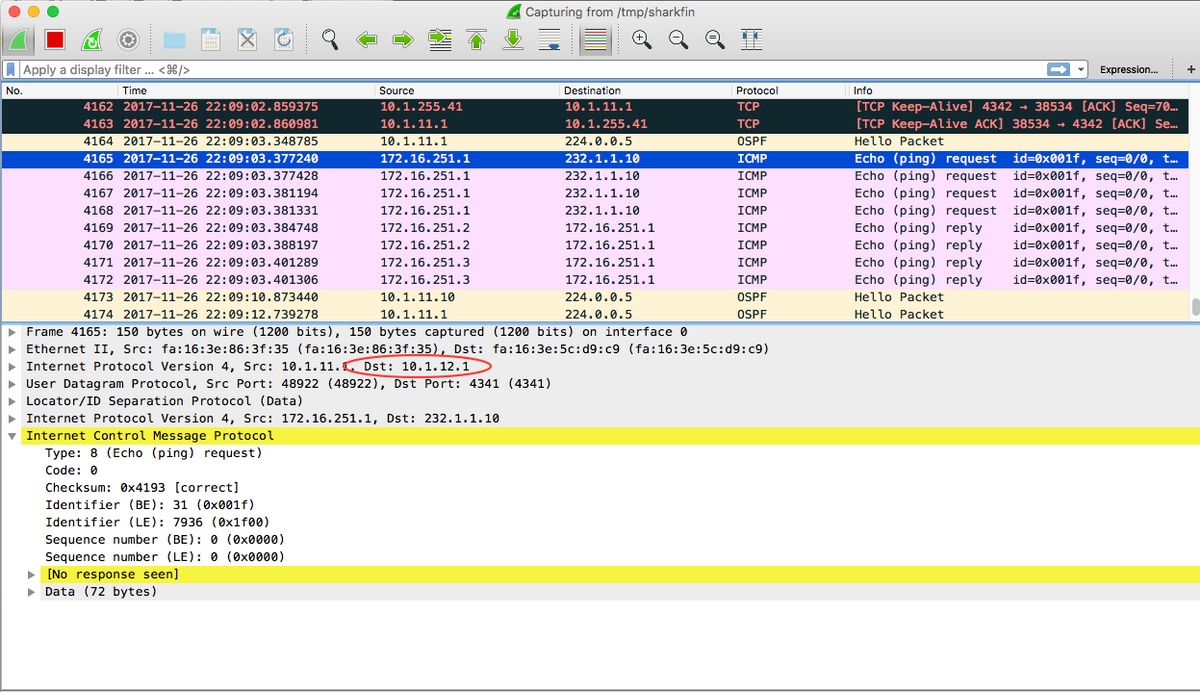
El destino del paquete encapsulado es el RLOC para xTR2 como se muestra en la imagen.
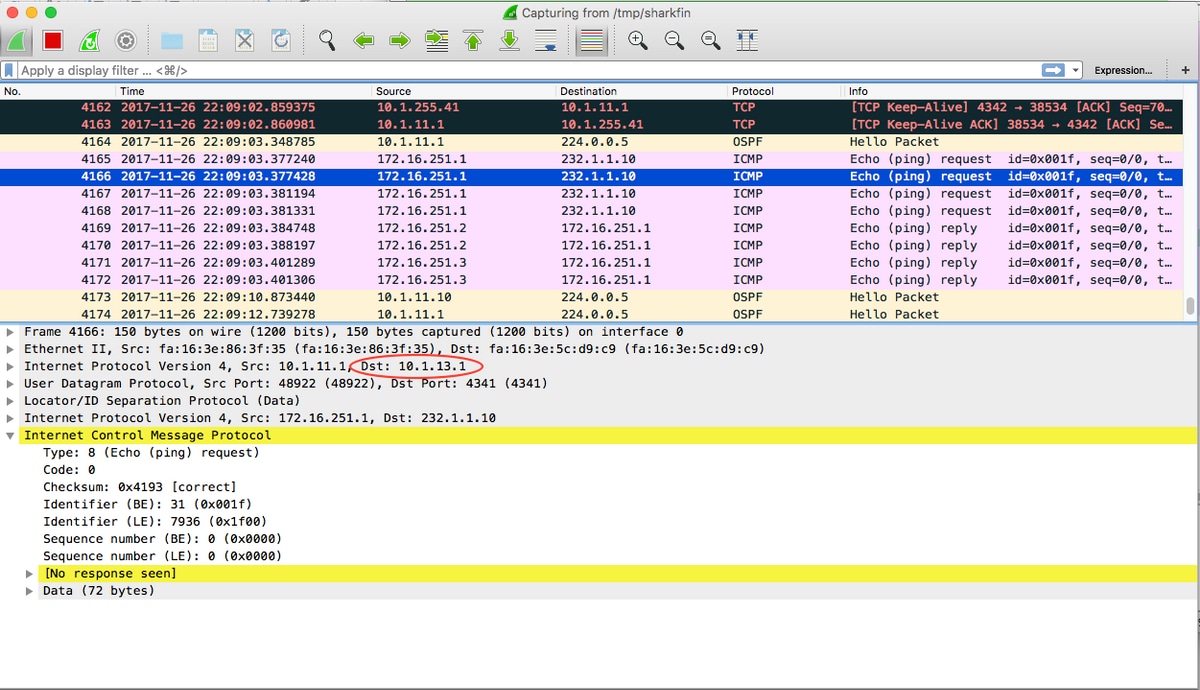
La IP de destino para el paquete es el RLOC de xTR3.
El flujo de multidifusión se replica en dos flujos de unidifusión y se envía a través del núcleo.
ASM
Nota: Sólo se soporta un Static-RP. No se soporta una redundancia RP.
Primero los registros de origen
Enviemos multidifusión desde CE1 al grupo 225.1.1.10. CE1 es el router de primer salto (FHR), por lo que activará un mensaje de registro de unidifusión en el RP (CE4). Como no tiene receptores, CE1 recibió un Register-Stop y crea entradas de ruta multicast.
CE1#ping 225.1.1.10 so lo10 Type escape sequence to abort. Sending 1, 100-byte ICMP Echos to 225.1.1.10, timeout is 2 seconds: Packet sent with a source address of 172.16.251.1 *Nov 27 14:29:04.083: PIM(0): Check RP 172.16.251.4 into the (*, 225.1.1.10) entry *Nov 27 14:29:04.084: PIM(0): Building Triggered (*,G) Join / (S,G,RP-bit) Prune message for 225.1.1.10 *Nov 27 14:29:04.089: PIM(0): Adding register encap tunnel (Tunnel0) as forwarding interface of (172.16.251.1, 225.1.1.10). *Nov 27 14:29:04.112: PIM(0): Received v2 Register-Stop on GigabitEthernet0/1.10 from 172.16.251.4 *Nov 27 14:29:04.112: PIM(0): for source 172.16.251.1, group 225.1.1.10 *Nov 27 14:29:04.113: PIM(0): Removing register encap tunnel (Tunnel0) as forwarding interface of (172.16.251.1, 225.1.1.10). *Nov 27 14:29:04.113: PIM(0): Clear Registering flag to 172.16.251.4 for (172.16.251.1/32, 225.1.1.10). CE1#sh ip mro 225.1.1.10 <…skip…> (*, 225.1.1.10), 00:02:16/stopped, RP 172.16.251.4, flags: SPF Incoming interface: GigabitEthernet0/1.10, RPF nbr 172.16.11.1 Outgoing interface list: Null (172.16.251.1, 225.1.1.10), 00:02:16/00:00:43, flags: PFT Incoming interface: Loopback10, RPF nbr 0.0.0.0 Outgoing interface list: Null
En el lado RP también se esperaba una imagen. Después de recibir un mensaje Register de CE1, RP (CE4) envía un mensaje Register-Stop y crea las rutas multicast necesarias.
CE4# *Nov 27 14:24:06.810: PIM(0): Received v2 Register on GigabitEthernet0/1.10 from 172.16.251.1 *Nov 27 14:24:06.810: for 172.16.251.1, group 225.1.1.10 *Nov 27 14:24:06.811: PIM(0): Check RP 172.16.251.4 into the (*, 225.1.1.10) entry *Nov 27 14:24:06.812: PIM(0): Adding register decap tunnel (Tunnel0) as accepting interface of (*, 225.1.1.10). *Nov 27 14:24:06.814: PIM(0): Adding register decap tunnel (Tunnel0) as accepting interface of (172.16.251.1, 225.1.1.10). *Nov 27 14:24:06.815: PIM(0): Send v2 Register-Stop to 172.16.251.1 for 172.16.251.1, group 225.1.1.10 CE4# *Nov 27 14:24:11.207: PIM(0): Building Periodic (*,G) Join / (S,G,RP-bit) Prune message for 224.0.1.40 CE4#sh ip mro 225.1.1.10 <…skip…> (*, 225.1.1.10), 00:00:31/stopped, RP 172.16.251.4, flags: SP Incoming interface: Null, RPF nbr 0.0.0.0 Outgoing interface list: Null (172.16.251.1, 225.1.1.10), 00:00:31/00:02:28, flags: P Incoming interface: GigabitEthernet0/1.10, RPF nbr 172.16.14.1 Outgoing interface list: Null
Tenga en cuenta que una interfaz Register-source debe estar en el rango EID de lo contrario LISP no se activará. De forma predeterminada, sería la dirección IP de la interfaz saliente.
CE1#sh run | i source ip pim register-source Loopback10
Para xTR1 y xTR4, nada cambió porque el tráfico multicast todavía no se ha recibido.
El receptor viene primero
Configuremos un receptor en la interfaz Lo10 en el dispositivo CE3.
CE3#conf t Enter configuration commands, one per line. End with CNTL/Z. CE3(config)#int lo10 CE3(config-if)#ip igmp join-group 225.1.1.10 CE3(config-if)#end
Se activa una (*,Join) y se crea una ruta multicast. Se espera todo.
CE3#
*Nov 27 14:48:46.271: PIM(0): Check RP 172.16.251.4 into the (*, 225.1.1.10) entry
*Nov 27 14:48:46.272: PIM(0): Building Triggered (*,G) Join / (S,G,RP-bit) Prune message for 225.1.1.10
*Nov 27 14:48:46.272: PIM(0): Upstream mode for (*, 225.1.1.10) changed from 0 to 1
*Nov 27 14:48:46.274: PIM(0): Insert (*,225.1.1.10) join in nbr 172.16.13.1's queue
*Nov 27 14:48:46.275: PIM(0): Building Triggered (*,G) Join / (S,G,RP-bit) Prune message for 225.1.1.10
*Nov 27 14:48:46.284: PIM(0): Building Join/Prune packet for nbr 172.16.13.1
*Nov 27 14:48:46.284: PIM(0): Adding v2 (172.16.251.4/32, 225.1.1.10), WC-bit, RPT-bit, S-bit Join
*Nov 27 14:48:46.285: PIM(0): Send v2 join/prune to 172.16.13.1 (GigabitEthernet0/1.10)
CE3#sh ip mro
< …skip…>
(*, 225.1.1.10), 00:26:23/00:02:42, RP 172.16.251.4, flags: SJCL
Incoming interface: GigabitEthernet0/1.10, RPF nbr 172.16.13.1
Outgoing interface list:
Loopback10, Forward/Sparse, 00:26:23/00:02:42
(*, 224.0.1.40), 21:32:32/00:02:03, RP 172.16.251.4, flags: SJPCL
Incoming interface: GigabitEthernet0/1.10, RPF nbr 172.16.13.1
Outgoing interface list: Null
xTR3 recibe una participación (*,225.1.1.10). Se envía una unión (*,G) al RP. xTR3 verifica el RLOC para el RP (172.16.251.4). Como se puede alcanzar a través del LISP, se crea el vecino PIM al RLOC apropiado. En este caso, es 10.1.14.1.
xTR3#
*Nov 27 14:30:23.229: PIM(0): Received v2 Join/Prune on GigabitEthernet0/2.10 from 172.16.13.2, to us
*Nov 27 14:30:23.229: PIM(0): Join-list: (*, 225.1.1.10), RPT-bit set, WC-bit set, S-bit set
*Nov 27 14:30:23.231: PIM(0): Check RP 172.16.251.4 into the (*, 225.1.1.10) entry
*Nov 27 14:30:23.233: PIM(0): Add GigabitEthernet0/2.10/172.16.13.2 to (*, 225.1.1.10), Forward state, by PIM *G Join
*Nov 27 14:30:23.247: PIM(0): Building Triggered (*,G) Join / (S,G,RP-bit) Prune message for 225.1.1.10
*Nov 27 14:30:23.247: PIM(0): Upstream mode for (*, 225.1.1.10) changed from 0 to 1
*Nov 27 14:30:23.248: PIM(0): Insert (*,225.1.1.10) join in nbr 10.1.14.1's queue
xTR3#
*Nov 27 14:30:23.259: PIM(0): Building Join/Prune packet for nbr 10.1.14.1
*Nov 27 14:30:23.259: PIM(0): Adding v2 (172.16.251.4/32, 225.1.1.10), WC-bit, RPT-bit, S-bit Join
*Nov 27 14:30:23.260: PIM(0): Send v2 join/prune to 10.1.14.1 (LISP0)
xTR3#sh ip pim nei
PIM Neighbor Table
Mode: B - Bidir Capable, DR - Designated Router, N - Default DR Priority,
P - Proxy Capable, S - State Refresh Capable, G - GenID Capable,
L - DR Load-balancing Capable
Neighbor Interface Uptime/Expires Ver DR
Address Prio/Mode
172.16.13.2 GigabitEthernet0/2.10 21:54:17/00:01:27 v2 1 / DR S P G
10.1.14.1 LISP0 00:26:16/00:01:35 v2 0 /
Comprobemos una captura de Wireshark como se muestra en la imagen.
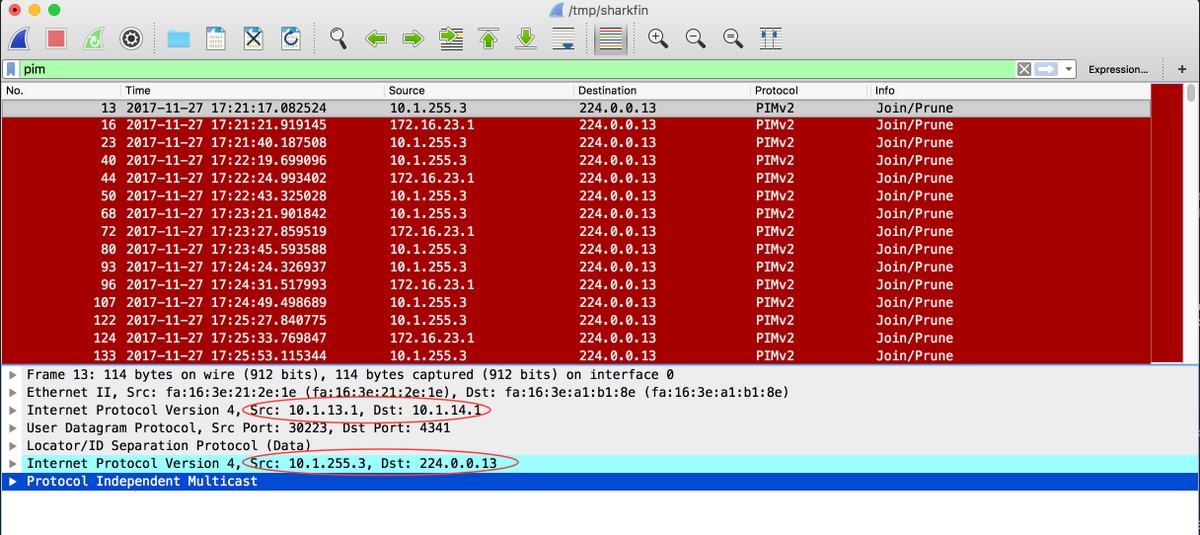
El origen IP externo es el RLOC local y el destino IP externo es el RLOC remoto. El origen interno es la dirección IP tomada para la interfaz LISP0. La dirección IP de destino interno es la dirección de multidifusión PIM normal 224.0.0.13.
Se creará una ruta multicast (*,G). Una interfaz entrante/RPF para el RP es la interfaz LISP0.
xTR3#sh ip mro 225.1.1.10
<…skip…>
(*, 225.1.1.10), 00:42:51/00:03:25, RP 172.16.251.4, flags: S
Incoming interface: LISP0, RPF nbr 10.1.14.1
Outgoing interface list:
GigabitEthernet0/2.10, Forward/Sparse, 00:42:51/00:03:25
xTR3#sh int LISP0 | i address
Interface is unnumbered. Using address of Loopback0 (10.1.255.3)
En xTR4 se recibe una unión (*,G) del túnel LISP. Se crea una ruta multicast apropiada.
xTR4#
*Nov 27 14:38:20.880: PIM(0): Received v2 Join/Prune on LISP0 from 10.1.255.3, to us
*Nov 27 14:38:20.881: PIM(0): Join-list: (*, 225.1.1.10), RPT-bit set, WC-bit set, S-bit set
*Nov 27 14:38:20.883: PIM(0): Check RP 172.16.251.4 into the (*, 225.1.1.10) entry
*Nov 27 14:38:20.883: PIM(0): Building Triggered (*,G) Join / (S,G,RP-bit) Prune message for 225.1.1.10
*Nov 27 14:38:20.884: PIM(0): Add LISP0/10.1.13.1 to (*, 225.1.1.10), Forward state, by PIM *G Join
*Nov 27 14:38:20.885: PIM(0): Building Triggered (*,G) Join / (S,G,RP-bit) Prune message for 225.1.1.10
*Nov 27 14:38:20.885: PIM(0): Upstream mode for (*, 225.1.1.10) changed from 0 to 1
xTR4#
*Nov 27 14:38:20.885: PIM(0): Insert (*,225.1.1.10) join in nbr 172.16.14.2's queue
*Nov 27 14:38:20.886: PIM(0): Building Join/Prune packet for nbr 172.16.14.2
*Nov 27 14:38:20.886: PIM(0): Adding v2 (172.16.251.4/32, 225.1.1.10), WC-bit, RPT-bit, S-bit Join
*Nov 27 14:38:20.887: PIM(0): Send v2 join/prune to 172.16.14.2 (GigabitEthernet0/2.10)
xTR4#sh ip mro 225.1.1.10
<…skip…>
(*, 225.1.1.10), 00:45:05/00:02:56, RP 172.16.251.4, flags: S
Incoming interface: GigabitEthernet0/2.10, RPF nbr 172.16.14.2
Outgoing interface list:
LISP0, 10.1.13.1, Forward/Sparse, 00:45:05/00:02:56
En este caso, no se crea un vecino PIM en xTR4. El vecino PIM a CE4 solamente está presente.
xTR4#sh ip pim nei
PIM Neighbor Table
Mode: B - Bidir Capable, DR - Designated Router, N - Default DR Priority,
P - Proxy Capable, S - State Refresh Capable, G - GenID Capable,
L - DR Load-balancing Capable
Neighbor Interface Uptime/Expires Ver DR
Address Prio/Mode
172.16.14.2 GigabitEthernet0/2.10 22:00:37/00:01:20 v2 1 / DR S P G
Desde la perspectiva del RP todo se espera. Se crea una ruta multicast (*,G).
CE4#
*Nov 27 14:41:55.907: PIM(0): Building Periodic (*,G) Join / (S,G,RP-bit) Prune message for 224.0.1.40
CE4#
*Nov 27 14:42:11.841: PIM(0): Received v2 Join/Prune on GigabitEthernet0/1.10 from 172.16.14.1, to us
*Nov 27 14:42:11.841: PIM(0): Join-list: (*, 225.1.1.10), RPT-bit set, WC-bit set, S-bit set
*Nov 27 14:42:11.844: PIM(0): Check RP 172.16.251.4 into the (*, 225.1.1.10) entry
*Nov 27 14:42:11.845: PIM(0): Adding register decap tunnel (Tunnel0) as accepting interface of (*, 225.1.1.10).
*Nov 27 14:42:11.846: PIM(0): Add GigabitEthernet0/1.10/172.16.14.1 to (*, 225.1.1.10), Forward state, by PIM *G Join
CE4#sh ip mro
<…skip…>
(*, 225.1.1.10), 00:00:11/00:03:18, RP 172.16.251.4, flags: S
Incoming interface: Null, RPF nbr 0.0.0.0
Outgoing interface list:
GigabitEthernet0/1.10, Forward/Sparse, 00:00:11/00:03:18
(*, 224.0.1.40), 21:00:55/00:02:53, RP 172.16.251.4, flags: SJCL
Incoming interface: Null, RPF nbr 0.0.0.0
Outgoing interface list:
GigabitEthernet0/1.10, Forward/Sparse, 21:00:55/00:02:53
Conmutador de árbol de trayecto más corto (SPT)
Se supone que el árbol compartido ya está construido.
CE1 comienza a enviar tráfico al 225.1.1.10 desde la línea de origen Lo10 (172.16.251.1).
CE1#ping 225.1.1.10 so lo10 Type escape sequence to abort. Sending 1, 100-byte ICMP Echos to 225.1.1.10, timeout is 2 seconds: Packet sent with a source address of 172.16.251.1 Reply to request 0 from 172.16.251.3, 77 ms
El primer paquete multicast se encapsula en el mensaje unicast Register y se envía al RP.
.Nov 30 00:00:50.931: PIM(0): Check RP 172.16.251.4 into the (*, 225.1.1.10) entry .Nov 30 00:00:50.932: MRT(0): (*,225.1.1.10), RPF change from /0.0.0.0 to GigabitEthernet0/1.10/172.16.11.1 .Nov 30 00:00:50.932: PIM(0): Building Triggered (*,G) Join / (S,G,RP-bit) Prune message for 225.1.1.10 .Nov 30 00:00:50.933: MRT(0): Create (*,225.1.1.10), RPF (GigabitEthernet0/1.10, 172.16.11.1, 90/3072) .Nov 30 00:00:50.936: MRT(0): Reset the z-flag for (172.16.251.1, 225.1.1.10) .Nov 30 00:00:50.937: MRT(0): (172.16.251.1,225.1.1.10), RPF install from /0.0.0.0 to Loopback10/0.0.0.0 .Nov 30 00:00:50.937: PIM(0): Adding register encap tunnel (Tunnel0) as forwarding interface of (172.16.251.1, 225.1.1.10).
El paquete de registro se desencapsula en el RP y se envía sobre el árbol compartido al Receptor.
.Nov 30 00:00:51.540: PIM(0): Received v2 Register on GigabitEthernet0/1.10 from 172.16.251.1 .Nov 30 00:00:51.541: for 172.16.251.1, group 225.1.1.10 .Nov 30 00:00:51.542: PIM(0): Adding register decap tunnel (Tunnel0) as accepting interface of (172.16.251.1, 225.1.1.10).
Debido a la coincidencia entre la interfaz saliente para una (*,G) y una interfaz entrante para una (S,G), se inicia un temporizador de unión proxy para un (S,G), se establece el indicador X. Se trata de una situación específica de la topología (RP en un solo sentido).
CE4#sh ip mro
<…skip…>
(*, 225.1.1.10), 00:00:37/stopped, RP 172.16.251.4, flags: S
Incoming interface: Null, RPF nbr 0.0.0.0
Outgoing interface list:
GigabitEthernet0/1.10, Forward/Sparse, 00:00:37/00:02:52
(172.16.251.1, 225.1.1.10), 00:00:26/00:02:33, flags: PX
Incoming interface: GigabitEthernet0/1.10, RPF nbr 172.16.14.1
Outgoing interface list: Null
Por lo tanto, CE4 envía una (S,G) Unirse al Origen y no envía una (S,G) Sintonización.
.Nov 30 00:00:51.544: PIM(0): Insert (172.16.251.1,225.1.1.10) join in nbr 172.16.14.1's queue .Nov 30 00:00:51.546: PIM(0): Building Join/Prune packet for nbr 172.16.14.1 .Nov 30 00:00:51.546: PIM(0): Adding v2 (172.16.251.1/32, 225.1.1.10), S-bit Join .Nov 30 00:00:51.547: PIM(0): Send v2 join/prune to 172.16.14.1 (GigabitEthernet0/1.10)
Al mismo tiempo, el tráfico multicast desencapsulado se envía a los receptores a través de un árbol compartido como se muestra en las imágenes.
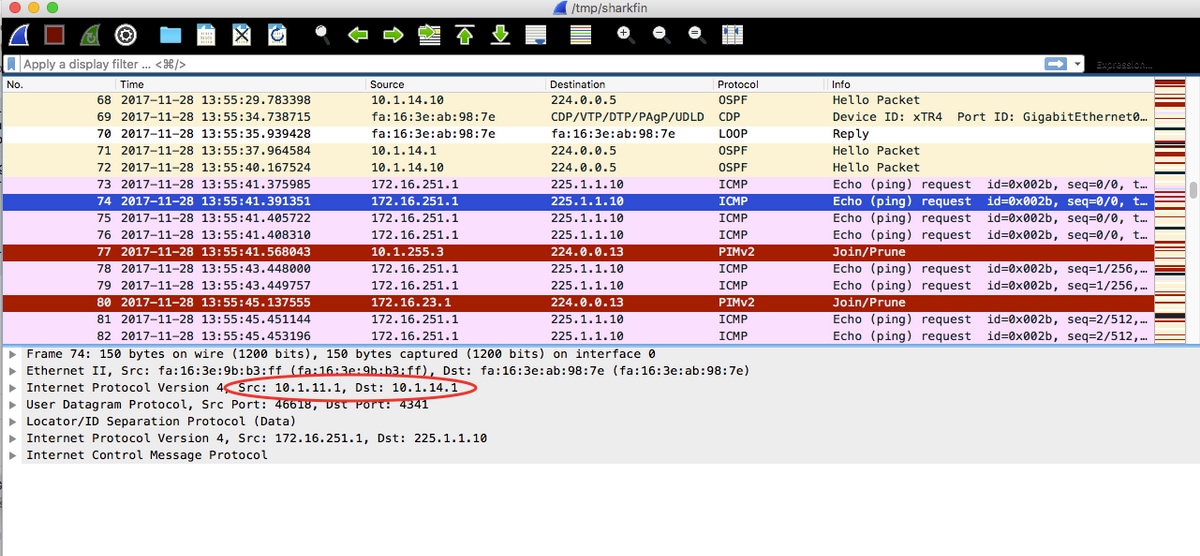
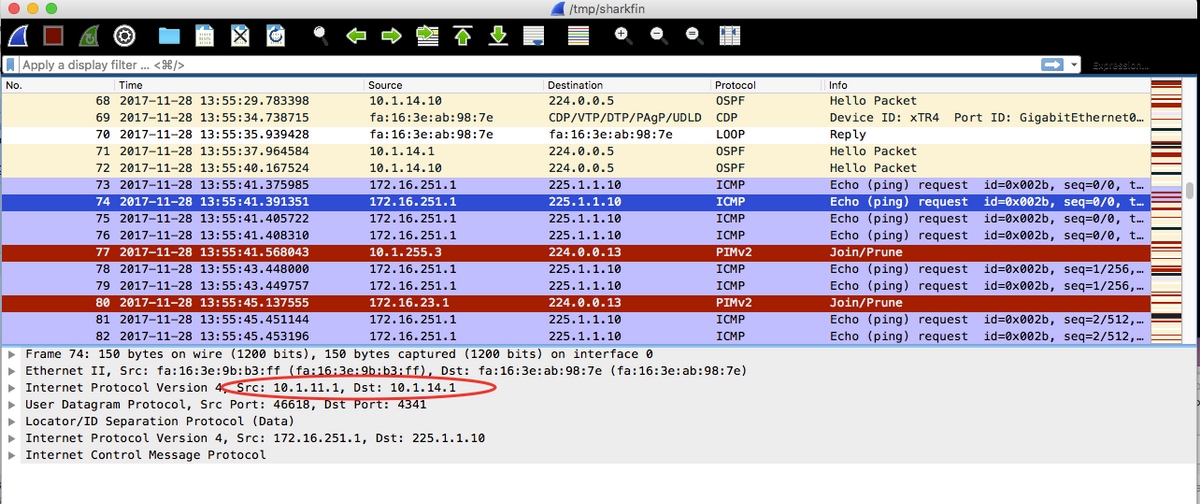
La captura de paquetes se realizó en la interfaz xTR4 g0/1.
En el primer paquete, la IP SRC y DST externa son 10.1.11.1 y 10.1.14.1.
En el segundo paquete, la IP SRC y DST externa son 10.1.14.1 y 10.1.13.1 respectivamente.
Después de recibir paquetes multicast, LHR CE3 está iniciando el switchover SPT. Se crea una ruta multicast para (S,G) y se establecen los indicadores J y T. Se envía una unión (S,G) hacia el origen.
.Nov 30 00:00:51.765: MRT(0): Set 'L' flag for (172.16.251.1, 225.1.1.10)
.Nov 30 00:00:51.766: MRT(0): Reset the z-flag for (172.16.251.1, 225.1.1.10)
.Nov 30 00:00:51.766: MRT(0): (172.16.251.1,225.1.1.10), RPF install from /0.0.0.0 to GigabitEthernet0/1.10/172.16.13.1
.Nov 30 00:00:51.767: MRT(0): Set the T-flag for (172.16.251.1, 225.1.1.10)
.Nov 30 00:00:51.768: PIM(0): Insert (172.16.251.1,225.1.1.10) join in nbr 172.16.13.1's queue
.Nov 30 00:00:51.768: MRT(0): Create (172.16.251.1,225.1.1.10), RPF (GigabitEthernet0/1.10, 172.16.13.1, 90/3072)
.Nov 30 00:00:51.769: MRT(0): WAVL Insert interface: Loopback10 in (172.16.251.1,225.1.1.10) Successful
.Nov 30 00:00:51.770: MRT(0): set min mtu for (172.16.251.1, 225.1.1.10) 18010->18010
.Nov 30 00:00:51.771: MRT(0): Add Loopback10/225.1.1.10 to the olist of (172.16.251.1, 225.1.1.10), Forward state - MAC not built
.Nov 30 00:00:51.771: MRT(0): Set the J-flag for (172.16.251.1, 225.1.1.10)
.Nov 30 00:00:51.780: PIM(0): Building Join/Prune packet for nbr 172.16.13.1
.Nov 30 00:00:51.780: PIM(0): Adding v2 (172.16.251.1/32, 225.1.1.10), S-bit Join
.Nov 30 00:00:51.781: PIM(0): Send v2 join/prune to 172.16.13.1 (GigabitEthernet0/1.10)
CE3#sh ip mro
<…skip…>
(*, 225.1.1.10), 00:01:36/stopped, RP 172.16.251.4, flags: SJCL
Incoming interface: GigabitEthernet0/1.10, RPF nbr 172.16.13.1
Outgoing interface list:
Loopback10, Forward/Sparse, 00:01:36/00:02:48
(172.16.251.1, 225.1.1.10), 00:00:25/00:02:34, flags: LJT
Incoming interface: GigabitEthernet0/1.10, RPF nbr 172.16.13.1
Outgoing interface list:
Loopback10, Forward/Sparse, 00:00:25/00:02:48
xTR3 está recibiendo una (S,G) incorporación desde CE3. Está verificando RPF para el Origen 172.16.251.1. Está activando una búsqueda LISP y crea un vecino PIM al RLOC 10.1.11.1 adicionalmente al vecino PIM al RLOC 10.1.14.1. Se crea una ruta multicast para (S,G) con un indicador T. La Unión A (S,G) se envía al Origen 172.16.255.1 a través del LISP0 RLOC 10.1.11.1
.Nov 30 00:00:51.104: PIM(0): Received v2 Join/Prune on GigabitEthernet0/2.10 from 172.16.13.2, to us
.Nov 30 00:00:51.105: PIM(0): Join-list: (172.16.251.1/32, 225.1.1.10), S-bit set
.Nov 30 00:00:51.105: PIM(0): RPF Lookup failed for 172.16.251.1
.Nov 30 00:00:51.108: MRT(0): Reset the z-flag for (172.16.251.1, 225.1.1.10)
.Nov 30 00:00:51.108: MRT(0): Create (172.16.251.1,225.1.1.10), RPF (unknown, 0.0.0.0, 0/0)
.Nov 30 00:00:51.109: MRT(0): WAVL Insert interface: GigabitEthernet0/2.10 in (172.16.251.1,225.1.1.10) Successful
.Nov 30 00:00:51.110: MRT(0): set min mtu for (172.16.251.1, 225.1.1.10) 18010->1500
.Nov 30 00:00:51.110: MRT(0): Add GigabitEthernet0/2.10/225.1.1.10 to the olist of (172.16.251.1, 225.1.1.10), Forward state - MAC built
.Nov 30 00:00:51.111: PIM(0): Add GigabitEthernet0/2.10/172.16.13.2 to (172.16.251.1, 225.1.1.10), Forward state, by PIM SG Join
.Nov 30 00:00:51.111: MRT(0): Add GigabitEthernet0/2.10/225.1.1.10 to the olist of (172.16.251.1, 225.1.1.10), Forward state - MAC built
.Nov 30 00:00:51.112: MRT(0): Set the PIM interest flag for (172.16.251.1, 225.1.1.10)
.Nov 30 00:00:51.128: MRT(0): (172.16.251.1,225.1.1.10), RPF change from /0.0.0.0 to LISP0/10.1.11.1
.Nov 30 00:00:51.130: MRT(0): Set the T-flag for (172.16.251.1, 225.1.1.10)
.Nov 30 00:00:51.130: PIM(0): Insert (172.16.251.1,225.1.1.10) join in nbr 10.1.11.1's queue
.Nov 30 00:00:51.134: PIM(0): Building Join/Prune packet for nbr 10.1.11.1
.Nov 30 00:00:51.134: PIM(0): Adding v2 (172.16.251.1/32, 225.1.1.10), S-bit Join
.Nov 30 00:00:51.135: PIM(0): Send v2 join/prune to 10.1.11.1 (LISP0)
xTR3#sh ip pim nei
PIM Neighbor Table
Mode: B - Bidir Capable, DR - Designated Router, N - Default DR Priority,
P - Proxy Capable, S - State Refresh Capable, G - GenID Capable,
L - DR Load-balancing Capable
Neighbor Interface Uptime/Expires Ver DR
Address Prio/Mode
172.16.13.2 GigabitEthernet0/2.10 2d16h/00:01:20 v2 1 / DR S P G
10.1.11.1 LISP0 00:00:19/00:01:39 v2 0 /
10.1.14.1 LISP0 1d18h/00:01:39 v2 0 /
xTR3#sh ip mro
<…skip…>
(*, 225.1.1.10), 00:01:29/stopped, RP 172.16.251.4, flags: S
Incoming interface: LISP0, RPF nbr 10.1.14.1
Outgoing interface list:
GigabitEthernet0/2.10, Forward/Sparse, 00:01:29/00:02:57
(172.16.251.1, 225.1.1.10), 00:00:19/00:02:40, flags: T
Incoming interface: LISP0, RPF nbr 10.1.11.1
Outgoing interface list:
GigabitEthernet0/2.10, Forward/Sparse, 00:00:19/00:03:10
Las interfaces RPF para un (*,G) y un (S,G) se vuelven diferentes: un árbol compartido (RLOC 10.1.14.1) y SPT (RLOC 10.1.11.1). Provoca un mensaje (S,G) de eliminación con bit RPT y Unión de bits S de xTR3 al RP.
.Nov 30 00:00:51.209: PIM(0): Insert (172.16.251.1,225.1.1.10) sgr prune in nbr 10.1.14.1's queue
.Nov 30 00:00:51.212: PIM(0): Building Join/Prune packet for nbr 10.1.14.1
.Nov 30 00:00:51.212: PIM(0): Adding v2 (172.16.251.4/32, 225.1.1.10), WC-bit, RPT-bit, S-bit Join
.Nov 30 00:00:51.213: PIM(0): Adding v2 (172.16.251.1/32, 225.1.1.10), RPT-bit, S-bit Prune
.Nov 30 00:00:51.214: PIM(0): Send v2 join/prune to 10.1.14.1 (LISP0)
xTR3#sh ip pim nei
PIM Neighbor Table
Mode: B - Bidir Capable, DR - Designated Router, N - Default DR Priority,
P - Proxy Capable, S - State Refresh Capable, G - GenID Capable,
L - DR Load-balancing Capable
Neighbor Interface Uptime/Expires Ver DR
Address Prio/Mode
172.16.13.2 GigabitEthernet0/2.10 4d09h/00:01:19 v2 1 / DR S P G
10.1.11.1 LISP0 00:00:58/00:01:02 v2 0 /
10.1.14.1 LISP0 3d11h/00:01:34 v2 0 /
xTR1 recibe un (S,G) Join de xTR3 para que activa la generación SPT. Un RPF para (*,G) es el RP al que se puede acceder a través de LISP. Se crea un vecino PIM para una verificación RPF en el RLOC 10.1.14.1. Se crean rutas multicast (*,G) y una (S,G).
.Nov 30 00:00:55.281: PIM(0): Received v2 Join/Prune on LISP0 from 10.1.255.3 .Nov 30 00:00:55.281: PIM(0): J/P Transport Attribute, Transport Type: Unicast, to us .Nov 30 00:00:55.282: PIM(0): Join-list: (172.16.251.1/32, 225.1.1.10), S-bit set .Nov 30 00:00:55.283: PIM(0): Check RP 172.16.251.4 into the (*, 225.1.1.10) entry .Nov 30 00:00:55.283: MRT(0): Create (*,225.1.1.10), RPF (unknown, 0.0.0.0, 0/0) .Nov 30 00:00:55.284: MRT(0): Reset the z-flag for (172.16.251.1, 225.1.1.10) .Nov 30 00:00:55.284: MRT(0): (172.16.251.1,225.1.1.10), RPF install from /0.0.0.0 to GigabitEthernet3.10/172.16.11.2 .Nov 30 00:00:55.284: MRT(0): Create (172.16.251.1,225.1.1.10), RPF (GigabitEthernet3.10, 172.16.11.2, 90/130816) .Nov 30 00:00:55.285: MRT(0): WAVL Insert LISP interface: LISP0 in (172.16.251.1,225.1.1.10) Next-hop: 10.1.13.1 Outer-source: 0.0.0.0 Successful .Nov 30 00:00:55.285: MRT(0): set min mtu for (172.16.251.1, 225.1.1.10) 18010->17892 .Nov 30 00:00:55.285: MRT(0): Set the T-flag for (172.16.251.1, 225.1.1.10) .Nov 30 00:00:55.286: MRT(0): Add LISP0/10.1.13.1 to the olist of (172.16.251.1, 225.1.1.10), Forward state - MAC not built .Nov 30 00:00:55.286: PIM(0): Add LISP0/10.1.13.1 to (172.16.251.1, 225.1.1.10), Forward state, by PIM SG Join .Nov 30 00:00:55.286: MRT(0): Add LISP0/10.1.13.1 to the olist of (172.16.251.1, 225.1.1.10), Forward state - MAC not built
También xTR1 recibe una Unión (S,G) del RP. Se agrega un LISP0 OIL a través del RLOC 10.1.14.1 al (S,G).
.Nov 30 00:00:55.295: PIM(0): Received v2 Join/Prune on LISP0 from 172.16.251.14
.Nov 30 00:00:55.295: PIM(0): J/P Transport Attribute, Transport Type: Unicast, to us
.Nov 30 00:00:55.295: PIM(0): Join-list: (172.16.251.1/32, 225.1.1.10), S-bit set
.Nov 30 00:00:55.295: MRT(0): WAVL Insert LISP interface: LISP0 in (172.16.251.1,225.1.1.10) Next-hop: 10.1.14.1 Outer-source: 0.0.0.0 Successful
.Nov 30 00:00:55.296: MRT(0): set min mtu for (172.16.251.1, 225.1.1.10) 17892->17892
.Nov 30 00:00:55.296: MRT(0): Add LISP0/10.1.14.1 to the olist of (172.16.251.1, 225.1.1.10), Forward state - MAC not built
.Nov 30 00:00:55.296: PIM(0): Add LISP0/10.1.14.1 to (172.16.251.1, 225.1.1.10), Forward state, by PIM SG Join
.Nov 30 00:00:55.297: MRT(0): Add LISP0/10.1.14.1 to the olist of (172.16.251.1, 225.1.1.10), Forward state - MAC not built
xTR1#sh ip mro
(*, 225.1.1.10), 00:00:27/stopped, RP 172.16.251.4, flags: SP
Incoming interface: LISP0, RPF nbr 10.1.14.1
Outgoing interface list: Null
(172.16.251.1, 225.1.1.10), 00:00:27/00:02:31, flags: T
Incoming interface: GigabitEthernet3.10, RPF nbr 172.16.11.2
Outgoing interface list:
LISP0, 10.1.14.1, Forward/Sparse, 00:00:27/00:03:01
LISP0, 10.1.13.1, Forward/Sparse, 00:00:27/00:03:01
xTR4 recibe una poda (S,G) del xTR3. LISP0 a 10.1.13.1 se excluye de un OIL.
Nov 30 00:00:50.771: PIM(0): Received v2 Join/Prune on LISP0 from 10.1.255.3, to us
Nov 30 00:00:50.772: PIM(0): Join-list: (*, 225.1.1.10), RPT-bit set, WC-bit set, S-bit set
Nov 30 00:00:50.774: PIM(0): Update LISP0/10.1.13.1 to (*, 225.1.1.10), Forward state, by PIM *G Join
Nov 30 00:00:50.774: MRT(0): Update LISP0/10.1.13.1 in the olist of (*, 225.1.1.10), Forward state - MAC not built
Nov 30 00:00:50.775: PIM(0): Prune-list: (172.16.251.1/32, 225.1.1.10) RPT-bit set
Nov 30 00:00:50.776: PIM(0): Prune LISP0/10.1.13.1 from (172.16.251.1/32, 225.1.1.10)
Nov 30 00:00:50.776: MRT(0): Delete LISP0/10.1.13.1 from the olist of (172.16.251.1, 225.1.1.10) - deleted
xTR4#sh ip mro
<…skip…>
(*, 225.1.1.10), 00:07:47/00:03:04, RP 172.16.251.4, flags: S
Incoming interface: GigabitEthernet0/2.10, RPF nbr 172.16.14.2
Outgoing interface list:
LISP0, 10.1.13.1, Forward/Sparse, 00:07:47/00:03:04
(172.16.251.1, 225.1.1.10), 00:00:26/00:02:33, flags:
Incoming interface: LISP0, RPF nbr 10.1.11.1
Outgoing interface list:
GigabitEthernet0/2.10, Forward/Sparse, 00:00:26/00:03:03
xTR4#sh ip pim nei
PIM Neighbor Table
Mode: B - Bidir Capable, DR - Designated Router, N - Default DR Priority,
P - Proxy Capable, S - State Refresh Capable, G - GenID Capable,
L - DR Load-balancing Capable
Neighbor Interface Uptime/Expires Ver DR
Address Prio/Mode
172.16.14.2 GigabitEthernet0/2.10 4d09h/00:01:16 v2 1 / DR S P G
10.1.11.1 LISP0 00:00:26/00:01:33 v2 0 /
El RP (CE4) recibe una separación (S,G) con el bit RPT configurado. El RP debe eliminar el origen del árbol compartido. El RP inicia una Prune (S,G) hacia el origen.
.Nov 30 00:01:34.811: PIM(0): Received v2 Join/Prune on GigabitEthernet0/1.10 from 172.16.14.1, to us .Nov 30 00:01:34.813: PIM(0): Prune-list: (172.16.251.1/32, 225.1.1.10) RPT-bit set .Nov 30 00:01:34.818: MRT(0): Set the T-flag for (172.16.251.1, 225.1.1.10) .Nov 30 00:01:34.818: PIM(0): Removing register decap tunnel (Tunnel0) as accepting interface of (172.16.251.1, 225.1.1.10). .Nov 30 00:01:34.819: PIM(0): Installing GigabitEthernet0/1.10 as accepting interface for (172.16.251.1, 225.1.1.10). .Nov 30 00:01:34.899: PIM(0): Insert (172.16.251.1,225.1.1.10) join in nbr 172.16.14.1's queue .Nov 30 00:01:34.902: PIM(0): Building Join/Prune packet for nbr 172.16.14.1 .Nov 30 00:01:34.903: PIM(0): Adding v2 (172.16.251.1/32, 225.1.1.10), S-bit Join .Nov 30 00:01:34.903: PIM(0): Send v2 join/prune to 172.16.14.1 (GigabitEthernet0/1.10) .Nov 30 00:01:39.398: PIM(0): Insert (172.16.251.1,225.1.1.10) prune in nbr 172.16.14.1's queue .Nov 30 00:01:39.399: PIM(0): Building Join/Prune packet for nbr 172.16.14.1 .Nov 30 00:01:39.401: PIM(0): Adding v2 (172.16.251.1/32, 225.1.1.10), S-bit Prune .Nov 30 00:01:39.402: PIM(0): Send v2 join/prune to 172.16.14.1 (GigabitEthernet0/1.10) CE4#sh ip mro <…skip…> (172.16.251.1, 225.1.1.10), 00:00:57/00:02:45, flags: PT Incoming interface: GigabitEthernet0/1.10, RPF nbr 172.16.14.1 Outgoing interface list: Null
xTR4 recibe una poda (S,G) iniciada por el RP y la envía al FHR (CE1). Gi0/2.10 está excluido de un PEOL.
Nov 30 00:01:38.620: PIM(0): Received v2 Join/Prune on GigabitEthernet0/2.10 from 172.16.14.2, to us
Nov 30 00:01:38.621: PIM(0): Prune-list: (172.16.251.1/32, 225.1.1.10)
Nov 30 00:01:38.622: PIM(0): Prune GigabitEthernet0/2.10/225.1.1.10 from (172.16.251.1/32, 225.1.1.10)
Nov 30 00:01:38.622: MRT(0): Delete GigabitEthernet0/2.10/225.1.1.10 from the olist of (172.16.251.1, 225.1.1.10)
Nov 30 00:01:38.624: MRT(0): Reset the PIM interest flag for (172.16.251.1, 225.1.1.10)
Nov 30 00:01:38.625: MRT(0): set min mtu for (172.16.251.1, 225.1.1.10) 1500->18010
Nov 30 00:01:38.626: PIM(0): Insert (172.16.251.1,225.1.1.10) prune in nbr 10.1.11.1's queue - deleted
Nov 30 00:01:38.628: PIM(0): Building Join/Prune packet for nbr 10.1.11.1
Nov 30 00:01:38.629: PIM(0): Adding v2 (172.16.251.1/32, 225.1.1.10), S-bit Prune
Nov 30 00:01:38.630: PIM(0): Send v2 join/prune to 10.1.11.1 (LISP0)
xTR4#sh ip mro
<…skip…>
(*, 225.1.1.10), 00:08:19/00:02:32, RP 172.16.251.4, flags: S
Incoming interface: GigabitEthernet0/2.10, RPF nbr 172.16.14.2
Outgoing interface list:
LISP0, 10.1.13.1, Forward/Sparse, 00:08:19/00:02:32
(172.16.251.1, 225.1.1.10), 00:00:57/00:02:02, flags: PT
Incoming interface: LISP0, RPF nbr 10.1.11.1
Outgoing interface list: Null
xTR1 recibe una (S,G) Prune de xTR4 y quita el LISP0 a través del RLOC 10.1.14.1 del OIL.
.Nov 30 00:01:47.450: PIM(0): Received v2 Join/Prune on LISP0 from 172.16.251.14
.Nov 30 00:01:47.450: PIM(0): J/P Transport Attribute, Transport Type: Unicast, to us
.Nov 30 00:01:47.450: PIM(0): Prune-list: (172.16.251.1/32, 225.1.1.10)
.Nov 30 00:01:47.451: PIM(0): Prune LISP0/10.1.14.1 from (172.16.251.1/32, 225.1.1.10)
.Nov 30 00:01:47.451: MRT(0): Delete LISP0/10.1.14.1 from the olist of (172.16.251.1, 225.1.1.10) – deleted
xTR1#sh ip mro
<…skip…>
(*, 225.1.1.10), 00:01:02/stopped, RP 172.16.251.4, flags: SP
Incoming interface: LISP0, RPF nbr 10.1.14.1
Outgoing interface list: Null
(172.16.251.1, 225.1.1.10), 00:01:02/00:01:57, flags: T
Incoming interface: GigabitEthernet3.10, RPF nbr 172.16.11.2
Outgoing interface list:
LISP0, 10.1.13.1, Forward/Sparse, 00:01:02/00:02:27
Ahora tiene un estado final.
FHR (CE1)
CE1#sh ip mro
<…skip…>
(*, 225.1.1.10), 00:01:46/stopped, RP 172.16.251.4, flags: SPF
Incoming interface: GigabitEthernet0/1.10, RPF nbr 172.16.11.1
Outgoing interface list: Null
(172.16.251.1, 225.1.1.10), 00:01:46/00:03:09, flags: FT
Incoming interface: Loopback10, RPF nbr 0.0.0.0
Outgoing interface list:
GigabitEthernet0/1.10, Forward/Sparse, 00:01:46/00:02:39, A
xTR1
xTR1#sh ip mro
<…skip…>
(*, 225.1.1.10), 00:01:02/stopped, RP 172.16.251.4, flags: SP
Incoming interface: LISP0, RPF nbr 10.1.14.1
Outgoing interface list: Null
(172.16.251.1, 225.1.1.10), 00:01:02/00:01:57, flags: T
Incoming interface: GigabitEthernet3.10, RPF nbr 172.16.11.2
Outgoing interface list:
LISP0, 10.1.13.1, Forward/Sparse, 00:01:02/00:02:27
xTR1#sh ip pim nei
PIM Neighbor Table
Mode: B - Bidir Capable, DR - Designated Router, N - Default DR Priority,
P - Proxy Capable, S - State Refresh Capable, G - GenID Capable,
L - DR Load-balancing Capable
Neighbor Interface Uptime/Expires Ver DR
Address Prio/Mode
172.16.11.2 GigabitEthernet3.10 16:23:01/00:01:29 v2 1 / DR S P G
10.1.14.1 LISP0 00:01:02/00:01:55 v2 0 /
LHR (CE3)
CE3#sh ip mro
<…skip…>
(*, 225.1.1.10), 00:10:10/stopped, RP 172.16.251.4, flags: SJCL
Incoming interface: GigabitEthernet0/1.10, RPF nbr 172.16.13.1
Outgoing interface list:
Loopback10, Forward/Sparse, 00:10:10/00:02:24
(172.16.251.1, 225.1.1.10), 00:01:46/00:01:13, flags: LJT
Incoming interface: GigabitEthernet0/1.10, RPF nbr 172.16.13.1
Outgoing interface list:
Loopback10, Forward/Sparse, 00:01:46/00:02:24
xTR3
xTR3#sh ip mro
<…skip…>
(*, 225.1.1.10), 00:09:05/00:03:15, RP 172.16.251.4, flags: S
Incoming interface: LISP0, RPF nbr 10.1.14.1
Outgoing interface list:
GigabitEthernet0/2.10, Forward/Sparse, 00:09:05/00:03:15
(172.16.251.1, 225.1.1.10), 00:01:44/00:01:15, flags: T
Incoming interface: LISP0, RPF nbr 10.1.11.1
Outgoing interface list:
GigabitEthernet0/2.10, Forward/Sparse, 00:01:44/00:03:15
xTR3#sh ip pim nei
PIM Neighbor Table
Mode: B - Bidir Capable, DR - Designated Router, N - Default DR Priority,
P - Proxy Capable, S - State Refresh Capable, G - GenID Capable,
L - DR Load-balancing Capable
Neighbor Interface Uptime/Expires Ver DR
Address Prio/Mode
172.16.13.2 GigabitEthernet0/2.10 4d09h/00:01:30 v2 1 / DR S P G
10.1.11.1 LISP0 00:01:44/00:01:14 v2 0 /
10.1.14.1 LISP0 3d11h/00:01:46 v2 0 /
RP(CE4)
CE4#sh ip mro
<…skip…>
(*, 225.1.1.10), 00:09:10/00:03:17, RP 172.16.251.4, flags: S
Incoming interface: Null, RPF nbr 0.0.0.0
Outgoing interface list:
GigabitEthernet0/1.10, Forward/Sparse, 00:09:10/00:03:17
(172.16.251.1, 225.1.1.10), 00:01:45/00:02:35, flags: PT
Incoming interface: GigabitEthernet0/1.10, RPF nbr 172.16.14.1
Outgoing interface list: Null
xTR4
xTR4#sh ip mro
<…skip…>
(*, 225.1.1.10), 00:09:05/00:02:44, RP 172.16.251.4, flags: S
Incoming interface: GigabitEthernet0/2.10, RPF nbr 172.16.14.2
Outgoing interface list:
LISP0, 10.1.13.1, Forward/Sparse, 00:09:05/00:02:44
(172.16.251.1, 225.1.1.10), 00:01:44/00:01:15, flags: PT
Incoming interface: LISP0, RPF nbr 10.1.11.1
Outgoing interface list: Null
xTR4#sh ip pim nei
PIM Neighbor Table
Mode: B - Bidir Capable, DR - Designated Router, N - Default DR Priority,
P - Proxy Capable, S - State Refresh Capable, G - GenID Capable,
L - DR Load-balancing Capable
Neighbor Interface Uptime/Expires Ver DR
Address Prio/Mode
172.16.14.2 GigabitEthernet0/2.10 4d09h/00:01:25 v2 1 / DR S P G
10.1.11.1 LISP0 00:01:44/00:01:47 v2 0 /
Verificación
Actualmente, no hay un procedimiento de verificación disponible para esta configuración.
Troubleshoot
Actualmente, no hay información específica de troubleshooting disponible para esta configuración.
Fuente
- RFC 6831 El LISP para entornos de multidifusión
Con la colaboración de ingenieros de Cisco
- Dmytro VishchukCisco TAC Engineer
Contacte a Cisco
- Abrir un caso de soporte

- (Requiere un Cisco Service Contract)
 Comentarios
Comentarios